Tents come in all shapes & sizes from tiny
one person single skin ones that you have to crawl into, to
enormous family dome tents designed to sleep 12 or more in
comfort and still have a communal living space. The general rule
seems to be if a tent says it is a 2 man tent then 2 people can
sleep in it & not much else. If your party is the average family
size say 2 adults and 2 children then you will probably find a
standard 4 man tent a bit of a squeeze especially on one of the
guaranteed rainy days here in the UK.
Look at tents with enough living space for all of you and all of
your kit. Think about somewhere to sit, maybe a table, cool box,
cooker & clothes in there and you will soon see how much room
you need. When choosing a tent many people make the mistake of
choosing the tent first and end up with one far too small for
their needs. Remember tents on the showground always look very
spacious and appear to be at least half as big again as they
actually are. This is because they are almost never displayed
with the usual kit inside them that you will have to take along.
So think about assembling the kit you want to
take to make life bearable for 24 hours inside your tent on a
rainy day and then find a tent that you can fit it and you
inside.
Now to the actual
tent.

Nylon type dome tents have evolved into a
technical wonder of the modern age. However the all share one
thing, they are designed to keep the occupants, you, and the
elements, wind & rain etc separate. All of the man made fibre
materials used in tent construction are graded with a HH figure.
HH stands for Hydroelastic Head and the figure is quoted in
millimetres. What this means is if you stood an open ended tube
on the fabric and started to fill it with water the height of
the water in mm before the fabric leaks is the HH figure quoted.
A general rule for camping here in the UK is the higher the HH
figure the better the tent will stand up to our weather. A HH of
2000 is usually considered the absolute minimum even for summer
use by the experienced camper and 3000 for use outside of our
short summer.
The picture above shows a single skin dome
tent probably not really suitable for much more than a childs
play tent for a number of reasons but it does show one factor
quite well that is becoming a very popular choice with many
campers. The tent above has a SIG, a Sewn In Groundsheet. This
means that the groundsheet is permanently attached to the outer
skin of the tent. It drastically cuts down on draughts which is
a very welcome innovation on a cold windy day. Tents with SIG
are becoming more common but are generally also more expensive
and also have a drawback when it comes to putting your tent
away. The underside of your groundsheet will become dirty and
when folding your tent that dirt will transfer to the fabric
which can affect both it's waterproofing and lifespan. To get
around this many campers simply use a separate groundsheet under
their tent.
Types of Tents
Hoop Tents
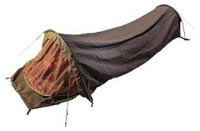 These
combine the features of the ridge and dome tents in a single
design. They are strong and offer plenty of room inside. The
hoop tent is favoured by the backpacker because of its
lightweight, size and strength.
These
combine the features of the ridge and dome tents in a single
design. They are strong and offer plenty of room inside. The
hoop tent is favoured by the backpacker because of its
lightweight, size and strength.
Frame Tents
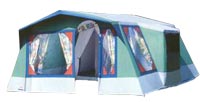 These
have the best all round headroom and living space. They offer
separate sleeping compartments, kitchen and living area. The
frame is generally constructed of tubular steel. Canvas is
generally made from a cotton blend and with care will last in
excess of 20 years.
These
have the best all round headroom and living space. They offer
separate sleeping compartments, kitchen and living area. The
frame is generally constructed of tubular steel. Canvas is
generally made from a cotton blend and with care will last in
excess of 20 years.
Trailer Tents
Similar in looks and design to the Frame Tent but the main
bedroom compartments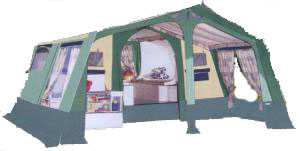
are built info a trailer. This provides above ground sleeping on
a proper bed.
The bedrooms and canvas fold out from the trailer allowing the
cabin to be set up in 5 to 10 minuets. The living space is
erected and zipped onto the main cabin. Lots of trailer tents
have a built in kitchen including a cooker and sink which can be
used without unpacking the tent. Trailers also have storage
compartments built in.
Dome Tents
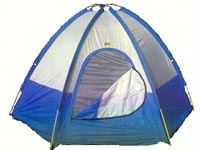 These
are very simple to erect using lightweight flexible poles that
thread through a sleeve in the tent fabric. The poles are
usually made form fibre-glass or alloy. This type of tent is a
great choice for the backpacker and can range from a 1 berth up
to family sized.
These
are very simple to erect using lightweight flexible poles that
thread through a sleeve in the tent fabric. The poles are
usually made form fibre-glass or alloy. This type of tent is a
great choice for the backpacker and can range from a 1 berth up
to family sized.
Geodesic Tents
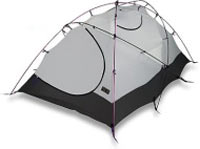 These
are very similar to the dome tents, except that they have a
different pole configuration. The flexible poles cross at
different levels and hold the fabric taut and because of this
are better suited than other tents in windy conditions.
These
are very similar to the dome tents, except that they have a
different pole configuration. The flexible poles cross at
different levels and hold the fabric taut and because of this
are better suited than other tents in windy conditions.
Touring Tents
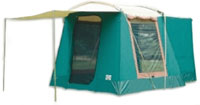 These
have an extended ridge and dome and a good size porch area for
shade, shelter or cooking; some even have windows. The poles are
of tubular steel, alloy or fibre-glass.
These
have an extended ridge and dome and a good size porch area for
shade, shelter or cooking; some even have windows. The poles are
of tubular steel, alloy or fibre-glass.
VIS-À-VIS
 This
is a term that applies to tents with sleeping compartments on
either side of a living area. The basic tent can be either ridge
or dome style. Most are made in lightweight nylon or polyester.
This
is a term that applies to tents with sleeping compartments on
either side of a living area. The basic tent can be either ridge
or dome style. Most are made in lightweight nylon or polyester.
Ridge Tents
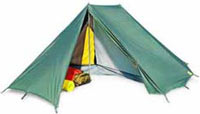 These
are triangular in shape with a horizontal pole supported by two
vertical end poles. These tents are very sturdy with plenty of
headroom; however, the sides are unsupported so it is advisable
that these tents are pitched end on to the wind, by the guy
ropes.
These
are triangular in shape with a horizontal pole supported by two
vertical end poles. These tents are very sturdy with plenty of
headroom; however, the sides are unsupported so it is advisable
that these tents are pitched end on to the wind, by the guy
ropes.
Images are for illustration purposes only





 These
combine the features of the ridge and dome tents in a single
design. They are strong and offer plenty of room inside. The
hoop tent is favoured by the backpacker because of its
lightweight, size and strength.
These
combine the features of the ridge and dome tents in a single
design. They are strong and offer plenty of room inside. The
hoop tent is favoured by the backpacker because of its
lightweight, size and strength. These
have the best all round headroom and living space. They offer
separate sleeping compartments, kitchen and living area. The
frame is generally constructed of tubular steel. Canvas is
generally made from a cotton blend and with care will last in
excess of 20 years.
These
have the best all round headroom and living space. They offer
separate sleeping compartments, kitchen and living area. The
frame is generally constructed of tubular steel. Canvas is
generally made from a cotton blend and with care will last in
excess of 20 years.
 These
are very simple to erect using lightweight flexible poles that
thread through a sleeve in the tent fabric. The poles are
usually made form fibre-glass or alloy. This type of tent is a
great choice for the backpacker and can range from a 1 berth up
to family sized.
These
are very simple to erect using lightweight flexible poles that
thread through a sleeve in the tent fabric. The poles are
usually made form fibre-glass or alloy. This type of tent is a
great choice for the backpacker and can range from a 1 berth up
to family sized. These
are very similar to the dome tents, except that they have a
different pole configuration. The flexible poles cross at
different levels and hold the fabric taut and because of this
are better suited than other tents in windy conditions.
These
are very similar to the dome tents, except that they have a
different pole configuration. The flexible poles cross at
different levels and hold the fabric taut and because of this
are better suited than other tents in windy conditions. These
have an extended ridge and dome and a good size porch area for
shade, shelter or cooking; some even have windows. The poles are
of tubular steel, alloy or fibre-glass.
These
have an extended ridge and dome and a good size porch area for
shade, shelter or cooking; some even have windows. The poles are
of tubular steel, alloy or fibre-glass. This
is a term that applies to tents with sleeping compartments on
either side of a living area. The basic tent can be either ridge
or dome style. Most are made in lightweight nylon or polyester.
This
is a term that applies to tents with sleeping compartments on
either side of a living area. The basic tent can be either ridge
or dome style. Most are made in lightweight nylon or polyester. These
are triangular in shape with a horizontal pole supported by two
vertical end poles. These tents are very sturdy with plenty of
headroom; however, the sides are unsupported so it is advisable
that these tents are pitched end on to the wind, by the guy
ropes.
These
are triangular in shape with a horizontal pole supported by two
vertical end poles. These tents are very sturdy with plenty of
headroom; however, the sides are unsupported so it is advisable
that these tents are pitched end on to the wind, by the guy
ropes.